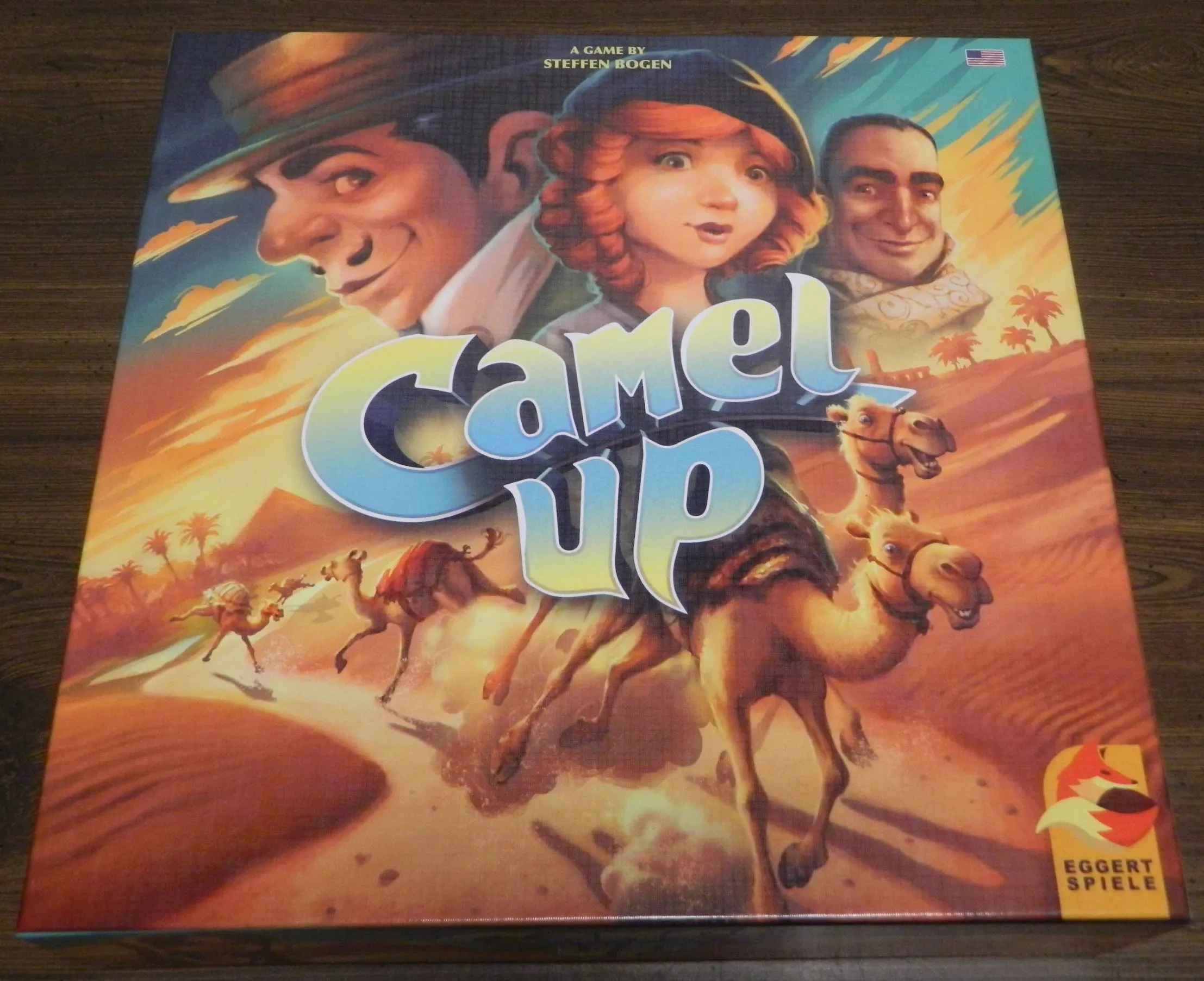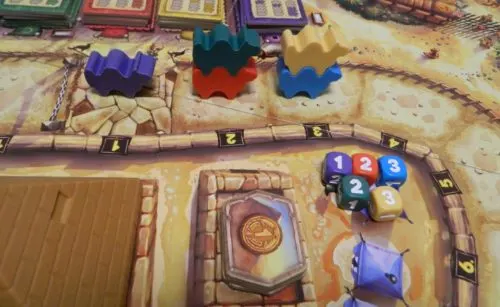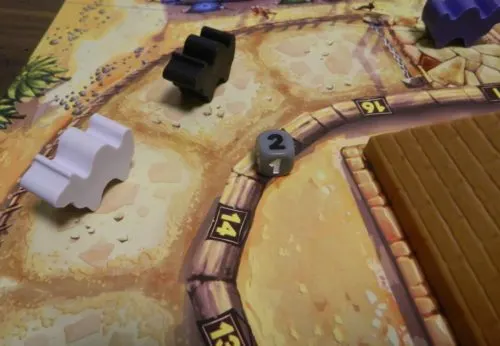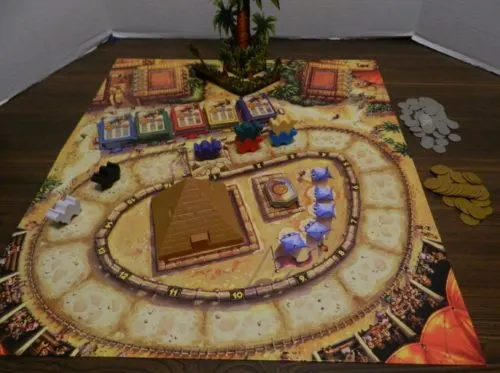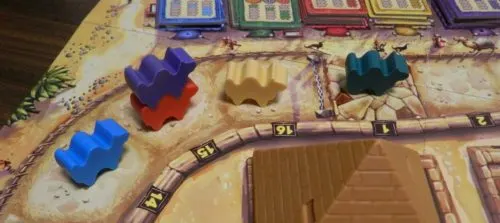Winning the Spiel Des Jahres (Game of the Year) in 2014, today’s game Camel Up immediately made a name for itself. While the Spiel Des Jahres doesn’t always pick the best game released every year, especially with more recent winners it usually means that the game at the very minimum is a good game. When you add in that Camel Up currently sits in the top 500 board games of all time on Board Game Geek, I was interested in checking it out. Generally I am not much of a fan of betting games, but Camel Up had enough interesting mechanics that I was intrigued to try it out. Camel Up may be a little overrated but it has some interesting mechanics that the whole family can enjoy.
How to Play Camel Up
These are the rules for the second edition of Camel Up. The rules for the first edition are the same except the “crazy camels” aren’t in the game.
Setup
- Place the gameboard in the middle of the table.
- Sort the betting tickets by their color. Place the tickets on their corresponding section of the gameboard. Place the tickets in order with the lowest valued tickets on the bottom.
- Place the pyramid tokens on their space on the gameboard.
- Sort the coins by their value and place them to the side of the board. Give each player three Egyptian Pounds.
- Each player chooses a character and takes the five finish cards for their chosen character. If you are playing with six or more players you will also take the corresponding partnership card and place it with the available side face up. Finally you will take the spectator tile of the character you chose. Each player will keep their finish cards hidden from the other players.
- Determine the starting position for all of the camels except the “crazy camels” (black and white). Roll each colored die and place the corresponding camel on one of the first three spaces based on what number you rolled. For example if you roll a one the camel will be put on the first space. For a two you will place them on space two and so on. If more than one camel is on the same space, randomly place the camels on top of each other. All of the camels should be placed so they face clockwise.
- To place the crazy camels you will roll the grey die. Choose which camel you will place first and roll the die. After you place the first camel you will roll the die again to determine the position for the other camel. If the second camel is placed on the same space as the first camel, the second camel will be placed on top of the first camel. The crazy camels will be placed so they face counterclockwise. The positions of the crazy camels are determined by the number that is rolled:
- One: Space 16
- Two: Space 15
- Three: Space 14
- Insert all of the dice into the pyramid and put on the top.
- Give the starting player marker to the youngest player who will start the game.
Playing the Game
On a player’s turn they will perform one action and then play will pass to the next player clockwise. The actions that a player can take on their turn are as follows:
- Take a betting ticket.
- Place a spectator tile.
- Take a pyramid ticket and move a camel
- Bet on the overall winner or loser of the race.
Take A Betting Token
A game of Camel Up consists of a series of legs that make up the race. A leg of Camel Up lasts until all of the pyramid tickets have been taken (five of the six dice have been rolled).
When a player chooses to take a betting ticket they are betting on which camel they think will win or place second in the current leg. To place a bet the player takes the top ticket of the camel they would like to bet on. A player can take tickets for several different camels or multiple tickets for the same camel.

This player has decided to take a betting ticket. They will choose a color and take the top betting ticket of that color.
Place A Spectator Tile
On your turn you can choose to place your spectator tile on the gameboard. If your spectator tile is already on the gameboard, you can use this turn to move it to another space. A spectator tile can only be placed on an empty space that does not contain any camels or spectator tiles. A spectator tile also cannot be placed on a space adjacent to another spectator tile or on the first space.
When placing the spectator tile you will choose whether you want to place the cheering side (+1 side) or the booing side (-1 side) face up.
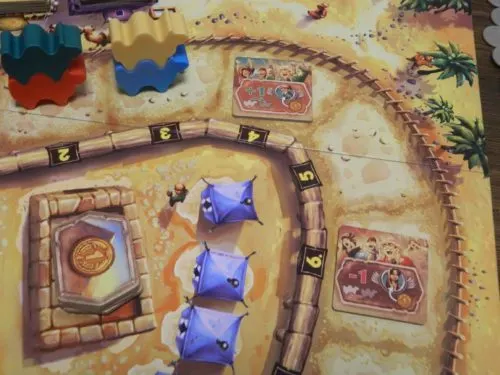
Two players have placed a spectator tile. The tile closer to the camels was placed with the cheering side up while the other tile was placed booing side up.
Take A Pyramid Ticket and Move A Camel
For their turn a player can also choose to take the top pyramid ticket and place it in front of them.
You will then push the button on the pyramid to determine which camel will move and how far they will move. Turn the pyramid upside down and shake it. Turn it upright and hold it a few inches above the table. Press the button which will release one of the dice. The color of the die that is revealed will determine which camel is moved. The number that is rolled determines how many spaces the camel is moved clockwise around the board. If a camel(s) ever lands on a space already occupied by another camel, the camel(s) that were just moved will be placed on top of the camel(s) that already occupy the space.
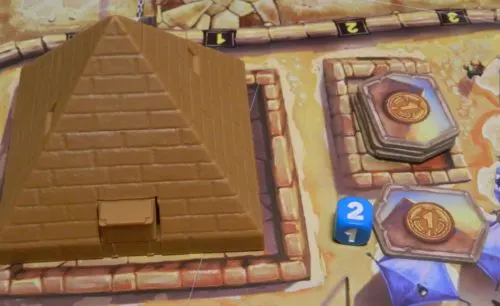
This player has chosen to move one of the camels. They will take one pyramid ticket. They rolled a two so they will move the blue camel two spaces.
If the camel you are moving has another camel on its back, it will take all of the camels on its back with it.
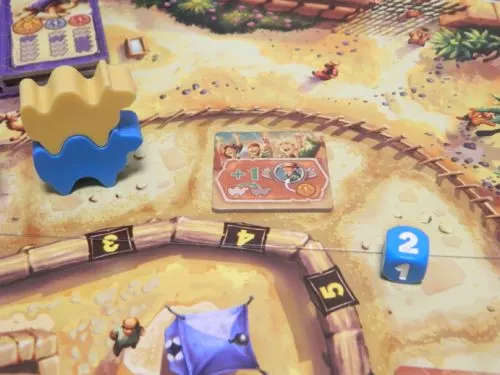
The blue die was rolled. The blue camel and the yellow camel on top of it will move forward two spaces.
If the grey die is revealed you will move one of the crazy camels. You will move the chosen crazy camel the number of spaces rolled counterclockwise. The crazy camel you will move depends on a couple factors.
- In most cases the color of the number that is rolled will determine which camel is moved. For example if a black number is rolled the black camel will be moved.
- If only one of the crazy camels are carrying another camel on its’ back though (not including the other crazy camel), the camel carrying another camel(s) will be moved.
- If one of the crazy camels is carrying the other crazy camel, you will move the camel that is on top of the other crazy camel.
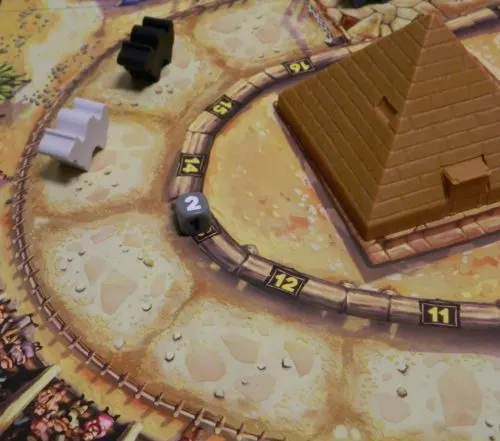
The crazy camel die has been rolled. As a white two was rolled the white camel will be moved two spaces counterclockwise.
If a camel is moved to a space that has a spectator tile on it, the player who owns the spectator tile will receive one Egyptian Pound from the bank. The camel and any camels on top of it are then moved based on which side of the tile was placed face up. If the player chose the cheering side the camel(s) is moved forward one space. If there are other camels on the new space, the camels that were moved to the space will be placed on top of the stack. If the player placed the booing side face up the camel(s) will be moved back one space. If there are any camels on the space they are moved to, the camel(s) that were moved to the space are moved to the bottom of the stack.
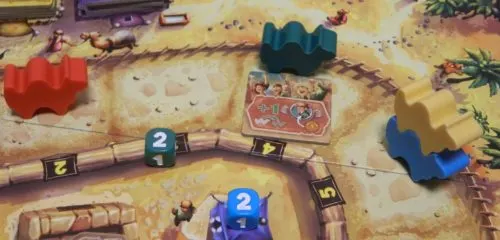
The green camel has landed on a spectator tile. The player who placed the tile will receive one coin. The green camel will also move forward one space as the cheering side was face up.
After you have completed moving the camel(s) place the die onto one of the dice tents to show that it has already been used this leg.
Bet On The Overall Winner Or Loser
For this action the players can bet on which camel they think will be the overall winner or loser of the entire race. To bet on either you will use your finish cards. Choose the card corresponding to the camel you want to bid on without letting the other players know. Then place the card face down on the space corresponding to whether you are betting on the overall winner or loser. If there are already cards on the space you will place your card on top of the previously played cards. Once you place a card you cannot pick it up or change its location for the rest of the game. You can make multiple bets for the overall winner or loser though.
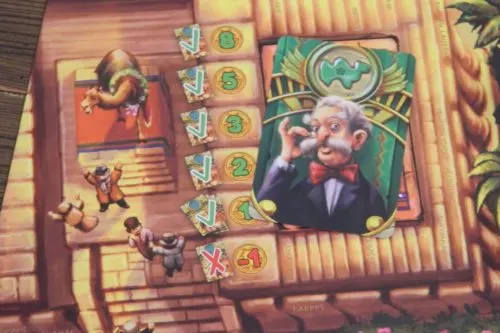
This player has bet on the green camel being the overall winner. Normally the player would play this card face down.
End of Leg
A leg ends when someone draws the last pyramid ticket and the fifth camel is moved for the leg. The starting player token is given to the next player to indicate that they will take the next turn after the scoring for the current leg is completed.
First players will determine which camel is in first and second place (the camels closest to the finish line). The crazy camels do not count towards determining who is in first and second. If there are multiple camels on the same space the camel at the top of the stack is ahead of the camels beneath it.

The current leg has ended. The green camel is currently in first place as it is on top of the stack that is furthest along the track. The yellow camel is in second place.
Each player that bet on the camel in first place will take coins from the bank corresponding to the first place value on all of the tickets that they own. All of the players that bet on the camel in second will receive coins from the bank equal to the value of second place on all of their tickets. Players will lose one coin for each bet they made on a camel that didn’t place in first or second.
Next players will receive one coin for each pyramid ticket they took during the previous leg.
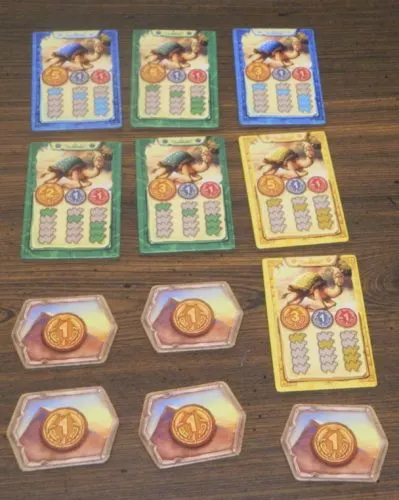
Players will score points as follows. The left player will lose one point for the blue ticket, they will score two points for the green ticket (green got first), and they will receive two points for the pyramid tickets.The middle player will score eight points for the green tickets and two points for the pyramid tickets. The right player will lose one point for the blue ticket, they will gain two points for the yellow tickets (the yellow camel is in second place), and they will score one point for the pyramid ticket.
After every player has taken the money they earned and paid the money they lost, the game is reset for the next leg.
- All of the betting tickets are returned to their corresponding spots on the gameboard. The lowest values of each color are placed on the bottom while the highest values are placed on the top.
- All of the pyramid tickets are returned to their spot on the gameboard.
- Any player who placed their spectator tile on the gameboard will take it back.
- All of the dice are returned to the pyramid.
- The player with the starting player marker will then take their turn.
End of Game
The game ends immediately when one of the camels cross the finish line. This includes a crazy camel crossing the line in the opposite direction. If a crazy camel moves another camel across the finish line in the opposite direction, this camel(s) are considered in last place.
To begin the players will conduct one more round of end of leg scoring (see above).
Then the players will conduct scoring for the overall winner and loser of the race. Start with determining the ultimate winner. The ultimate winner is the camel that crosses the finish line or was furthest along the track when the race ended. Crazy camels cannot place in first or last place. Take all of the cards on the overall winner space and flip them over so the card that was first played is now at the top of the stack. Go through each card to determine if the player was correct. The first player to play the right card will receive eight Egyptian Pounds. The second player to play the right cards will receive five Egyptian Pounds. Each consecutive player to guess correctly will receive the next highest value on the corresponding chart.
Each card that was incorrectly played in the overall winner pile costs one Egyptian Pound to the player who played it.
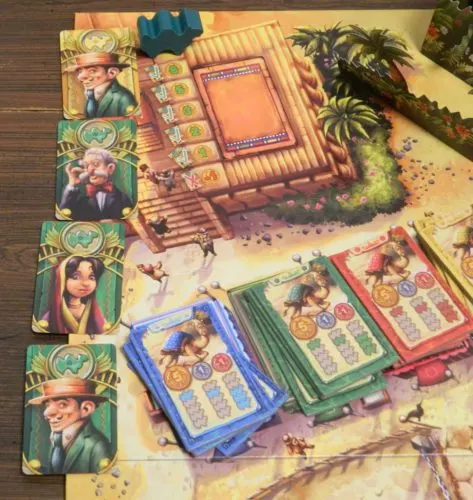
The green camel has won the race. The first player picked the wrong camel so they will lose one coin. The second player picked the right color so they will earn eight coins. The third card is right so they will earn five coins. The fourth card was right so they will earn three coins.
After you have scored the overall winner pile, score the overall loser pile. The overall loser is the camel that traveled the least in the race. Camels that crossed the finish line in the opposite direction are considered last. Scoring for the overall loser is the same as the overall winner.
Each player will then count up how much money they have. The player with the most money wins the game. If two or more players are tied for the most money, the tied players share the victory.
Additional Rules for Six Plus Players
If you play the game with six or more players, there are a couple additional rules for the game.
First each player will take their partnership card at the beginning of the game. They will place the card with the available side up.
The six plus player rules also include a fifth action for each turn. For this action each player can enter a betting partnership with another player. On your turn you can take this action if your partnership card has the available side face up in front of you. For this action you will choose one of the other players who still has their partnerhip card available side up in front of them. The two players will exchange their partnership cards and turn them to the partnership side. The player that you chose cannot refuse the partnership.
At the end of the leg each player can score points for one of the betting tickets that their partner collected. If a player doesn’t want to use any or their partner’s betting tickets they don’t have to. Each player will score points for all of their own betting tickets as well as one of the tickets chosen from their partner. After scoring is completed all partnerships are ended and each player takes back their partnership card and places it in front of them available side up.
My Thoughts on Camel Up
When a board game wins a Spiel Des Jahres there are usually a couple things that you can always expect out of the game as the judges generally follow a couple criteria. First the game will be pretty easy to play. This is due to the award being designed to recognize games that the whole family can enjoy. Second the games tend to have a good balance between strategy and luck. The committee seems to like games that have some luck but also enough strategy where you can impact your fate in the game. Finally the Spiel Des Jahres tends to reward games that come up with new gameplay mechanics or find a way to use mechanics in a new way. The reason I brought up these three criteria is that I think they do a really good job describing Camel Up.
Lets begin with Camel Up’s difficulty. While Camel Up is more difficult than your typical mainstream game, the game is still quite easy to play. On each turn you can choose between four (five if you are playing with six or more players) actions. While there are four actions to choose from, each action is quite simple where players should have no troubles figuring out what each action does. While the game has a decent amount of rules, they are quite straightforward and common sense for the most part. I would guess that you could teach the game to most new players within five to ten minutes. The game has a recommended age of 8+ which seems appropriate as I would guess most kids that age shouldn’t have trouble playing the game. Camel Up also does a good job working as a bridge to more complicated games for people that only play mainstream board games.
While Camel Up is pretty easy to play, there is a decent amount of strategy as well. The game will never be confused for a strategy game as it relies on a decent amount of luck. Your fate in Camel Up will depend on the decisions you make though. The fact that Camel Up gives you a couple different choices for what you can do on a turn is probably the thing that I liked most about the game. These decisions you make will have an impact on how well you do in the game. On most turns it is usually pretty obvious what decisions you should make, but there are turns where you will have a couple different options.
At its core Camel Up is a betting game mixed with a roll and move game. Personally I am not much of a fan of betting games as I am not really a gambler. Betting on the outcome of an event just isn’t all that interesting to me. It is probably partially because I am usually not very good at betting on who will win a race. It is also because I don’t think there is a lot of skill in predicting who will win unless you are given information to make an informed decision. Another reason why I don’t like most betting board games is that they are usually really dull. You roll dice and move pieces until something crosses the finish line. This isn’t very exciting in my opinion.
The good news is that Camel Up overcomes a lot of the things that I generally don’t like about gambling games. While you are still rolling dice to move the camels, there is more to the game than that. What distinguishes Camel Up from other racing games though is that camels carry other camels on their backs. This leads to standings in the race changing quite quickly. A camel that lands on another camel or a stack of camels will be helped greatly as that camel could end up moving multiple times during a leg. The camel could then move off the stack and have other camels pass it moving it to the back of the pack. This mechanic adds a really interesting twist to your typical racing game.
This leads to the betting being more than just a random guess. There is some guessing when it comes to betting, but you can usually make a good educated guess. For example some camels can be so far back at the beginning of a leg that you know that they won’t come in first or second. Other camels could be so far ahead that they are guaranteed to be in first or second. Most of the time though you have to guess based on the current positioning of the camels. Camels on top of stacks are the most likely to place first or second as they could be moved multiple times in the leg. They could also be moved off the stack and have other camels moved past them or on top of them. Basically there is some risk and reward in the leg betting. If you make your bets earlier you can earn more coins. You are also more likely to be wrong and lose a coin. If you wait a while though you will have better information as you know which camels can still be moved which reduces the number of camels that can place first or second in the leg.
Then there is the betting on the overall winner and loser. This is actually a really interesting decision as there are different ways that you can approach the decision. The risky strategy is to bet on the overall winner and loser early in the game. Being the first player to correctly bet on the overall winner and loser will score quite a few more points than the other players that bet correctly. It is beneficial to wait as long as possible to play a card to one of these sections though as you will have more information. You don’t want to wait too long though or a bunch of the other players could play a card before you. Basically you need to balance between having enough information to make a bet and not waiting too long where your bet no longer really matters. Betting wrong will lose you a coin which isn’t that big of deal. The bigger punishment for betting wrong is that you can’t bet on the color in the other category if the race drastically changes where a camel goes from first to last or vice versa.
For the most part I enjoyed playing Camel Up. I think the game is a little overrated as I don’t think it deserved to win the Spiel Des Jahres. It is still a fun game though. I think the game succeeds because it does a good job combining a group of clever mechanics together that work well together. The game is easy to play and yet gives you enough strategic decisions where you can make a difference. The different decisions in the game allow you to pursue different strategies which allow you to play riskier or more conservatively. While there will be some turns that feel kind of worthless, most choices in the game can help you in one way or another.
While Camel Up is a good game it has a problem that can seriously impact some games. Basically Camel Up thrives on close races where the lead regularly changes. When you have a close race the game is exciting as you don’t know what is going to happen. Things can change quickly as a camel can go from first to last or vice versa in one leg. This forces you to take some risks when betting or choosing which action to take. If you don’t have a good race though the game kind of falls apart. In particular you don’t want a race where the ultimate winner and/or loser is obvious.
The problem with races that aren’t close is that it ruins what makes Camel Up a good game. A lot of the gameplay in Camel Up involves betting on where you think the camels will end up. In most games there is actually some decision making in this area as there will be movement between the legs. This gives you a couple different camels you can bet on at the beginning of each leg. When it is obvious who will be first or last the betting becomes pretty pointless. In some legs a camel could be guaranteed to win a leg as soon as it begins. Players will then just take turns taking the corresponding betting tickets. This ruins the betting mechanics as there is no reason to bet on any of the camels that have no chance at being first or second.
This leads to another problem with Camel Up where turn order can be critical. Being the first player to play in a leg can be crucial in the game. If you get the first turn in a leg you can take advantage of all of the actions. You can get the first choice of where to place a spectator tile. If you are in a race with a runaway leader you also get the opportunity to take the most valuable betting ticket for that camel in the current leg. While it isn’t totally in your control who gets to start a leg, if you can make a move that increases your odds of starting the next leg you should definitely consider making the move.
While Camel Up was originally released back in 2014, the second edition of the game was released in 2018. For this review I ended up using the second edition of Camel Up. Usually second editions of board games are basically the same as the first editions except for a couple component or artwork changes. Most of the differences between the first and second editions of Camel Up are cosmetic. The second edition has different artwork which looks really nice. The gameboard even includes a pop-up palm tree that helps set the mood. Otherwise the second edition replaces the wood and most of the cardboard pieces with plastic. This has some mixed results. The plastic pyramid seems quite a bit sturdier than the cardboard pyramid from the first edition. At the same time though while the plastic camels are pretty nice, I would always prefer wood playing pieces.
Unlike most second editions the second edition of Camel Up actually changes up the gameplay some. These changes mostly come from the addition of the crazy camels. The crazy camels basically run the race in reverse. They can’t win or lose the race. They are mostly used to mess with the other camels that are actually running the race. They can pick up camels and move them backwards towards the start line. A camel can be in first and a crazy camel can take them to the back of the pack.
I have some mixed feelings about the crazy camels. While the crazy camels mostly just add more luck/randomness to the game, in theory I liked them as they bring another aspect to the game. A camel can be way ahead and then be sent back to the middle of the pack. This can make the races more interesting as you can think a camel is about to win a leg/the race and then everything changes due to the crazy camels. Adding the crazy camels also slightly tweaks the rules. In the original game every camel will get to move each leg. With the crazy camels now in the mix one camel won’t get to move each turn. This adds some interesting decisions to the end of a leg as you debate who to bid on as one of the camels won’t move this leg. This forces you to consider more information before you bet on a camel.
I had two issues with the crazy camels though. First since all of the camels won’t move each turn, it means that the likelihood of an unexciting race increases. If a camel regularly has their die not rolled for a couple legs they are basically guaranteed to lose the race. The other problem that I had with the crazy camels is that they don’t seem to play a large role in the game. There will be races where they don’t impact the race at all. Even when they do they likely won’t have a big impact on the race. The only way they are going to have a big impact on the race is if everything goes right for them to move a camel(s) two or more times before the camel(s) get off its back.
At the end of the day I don’t know which version of the game is better. There are some things about the second edition that are better than the first and there are some other things that make the second edition worse.
Should You Buy Camel Up?
Camel Up is probably a little overrated, but it is still a very good game. Camel Up is basically what you would expect out of your typical Spiel Des Jahres winner. The game is quite simple where the whole family can enjoy it. The game gives players enough strategic decisions where it feels like you are actually having an impact on the ultimate outcome. The game also has a good collection of creative mechanics that usually leads to an exciting race that is close until the very end. Not being a huge fan of betting games, Camel Up is one of if not the best betting game that I have ever played. Unfortunately there are some races where it is really obvious which camels are going to win and which are going to lose. These races kind of ruin the experience as the betting mechanics are basically pointless in them. Turn order plays a pretty big role in the game and luck is important as well.
Camel Up is a game that I would recommend to most players. While better than most betting games, if you hate betting games Camel Up may not be for you. If the premise doesn’t really interest you or you mostly like really strategic games, Camel Up might also not be for you. People who want a good family or light designer game though should get quite a bit of enjoyment out of Camel Up.
If you would like to purchase Camel Up you can find it online: Amazon (First Edition), Amazon (Second Edition)
, eBay

